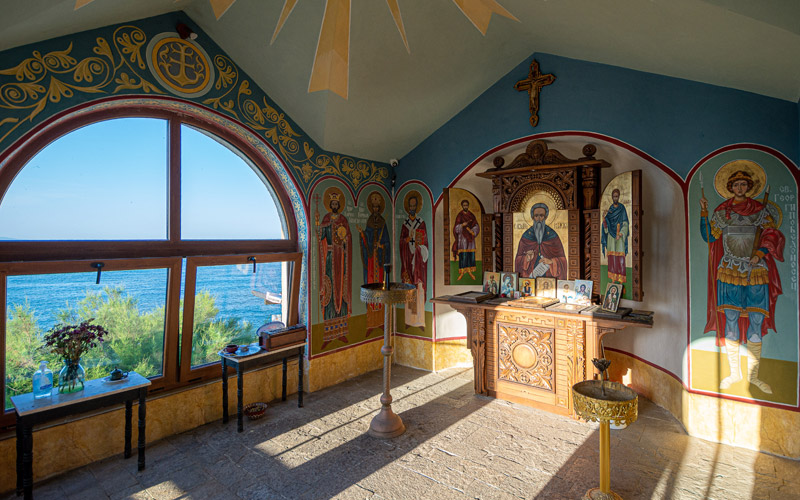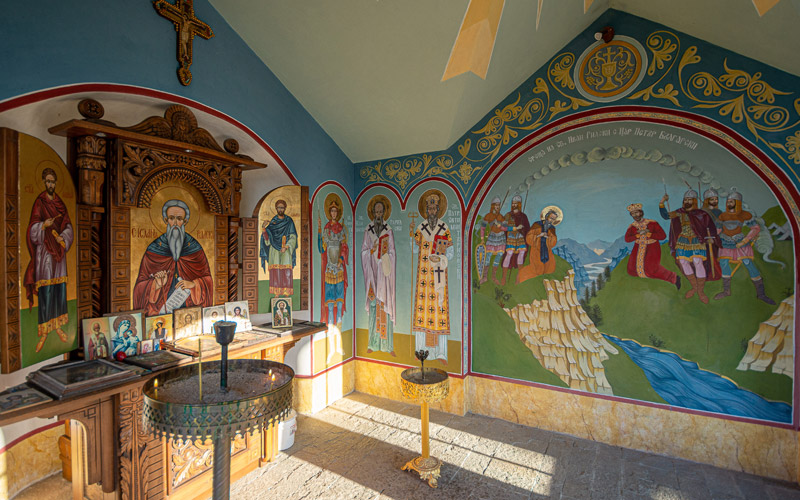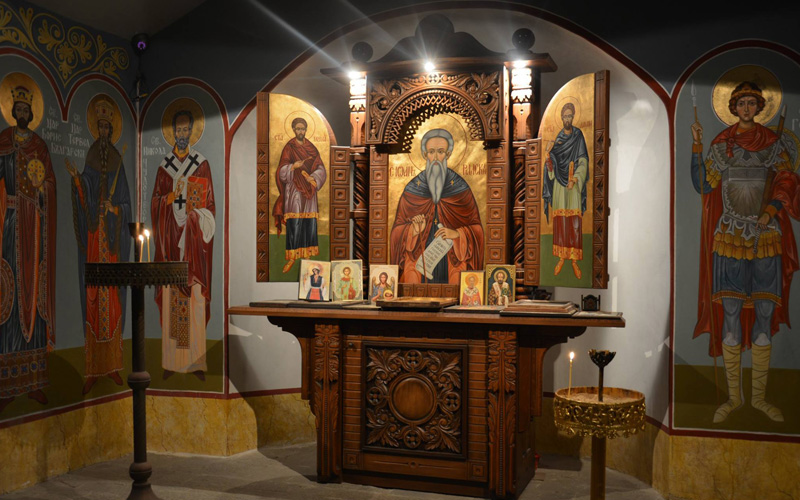Named after the patron saint of doctors, St Ivan, the House’s functioning chapel serves as a reminder of both Bulgaria’s national pride and the endurance of our Christian faith.
The small stone temple has been beautifully painted by talented icon artist, Kiril Kirilov, with the iconostasis the work of Associate Professor Daniela Evgenieva, and intricately carved by Tryavna master, Usta Darin. Two of the chapel’s icons are the work of Associate Professor Daniela Cherneva.
Anyone is welcome to walk inside, light a candle, say a prayer – with weddings and baptisms available.
Do not seek preeminence and principalities, but remember Him who said: 'He who would be greatest among you, let him be servant of all.''
CHAPEL OF ST. IVAN RILSKY - WONDERMAKER

Consecration of the Chapel of St Ivan of Rila
The beautiful temple named after the patron saint of doctors, St Ivan of Rila, has been open to both locals and guests of Sozopol for more than a decade. This small church which was built entirely from the private funds of Dr Nanyu Manafov and his wife Elena was consecrated in the autumn of 2010 by the bishop of Sliven Yoanikiy,
who proclaimed during the service. “This is a pious deed and whoever chooses to follow in the footsteps of Dr Manafov will be joyful and blessed, because the building of a chapel in such hard times is a priceless example.”
Among the beautifully painted icons is the image of St Tsar Tervel, a prominent figure in Bulgarian history. According to Sozopol-born Professor Bozhidar Dimitrov, a leading Bulgarian historian and long-standing head of the National Museum of History –
“Tsar Tervel must find his rightful place, not only in the historical memory of Bulgarians, but also in our Christian faith as someone who defended Christianity across the whole of Europe.”
Tsar Tervel was proclaimed a saint by both the Eastern and Western churches because he managed to defeat an army of 200,000 Arab soldiers near the Bosphorous in 716-117. At this time the Arabs attacked Europe from both the Gibraltar and the Bosphorous in an attempt to carry out the wishes of the Prophet Muhammad and impose Islam on the Old Continent. To the West they conquered and ruled over Spain for seven centuries and were stopped as late as 734 near the city of Poitiers, France by King Martel. But by the Bosphorous, where they attacked with 90% of their forces, they were crushed by Bulgarian soldiers under the command of Tsar Tervel.
Hence, Tervel was proclaimed not only a saint, but also a saviour of Europe and was celebrated as “St King Trivelius” in France, Germany and Italy up until the 18th century. Tens of novels, poems, plays by Western authors are dedicated to him.
“Tervel’s feat is somewhat forgotten today, but his icon in this chapel by the sea will remind us of Bulgaria’s contribution to Europe and the power of the Bulgarian spirit”
, noted Professor Dimitrov during the chapel’s consecration. A sacred church plate and a reliquary with a piece of the True Cross were two of the very first donations to the newly consecrated chapel in Sozopol.
Thus, pieces of the True Cross are kept in two separate Christian temples in Sozopol – St George church in the city’s centre and St Ivan of Rila chapel, built by the Doctor and his family.
A brief description of the life of St Ivan of Rila the Wonderworker
The biggest Bulgarian saint, the venerable Ivan of Rila was born in 876 in the village of Skrino, which is tucked away in the Osogovo Mountain by the Struma river. He was a contemporary of Tsar Boris (852-889) and his son Vladimir, Tsar Simeon the Great and his son – Tsar Peter. Ivan was a shephеrd until the age of 25. From a very young age, he embraced the Christian fate. During his time, many monasteries and churches were being built across Bulgaria.
The newly-established cloisters were not only hubs of Christianity, but also of education and enlightenment. The young man craved the idea of dedicating his life to serving God and becoming a monk in one such cloister. Ivan was first accepted in the nearby St Dimitar Monastery, located right underneath the mountain top of Ruen. There he not only indulged in spiritual contemplation but also gained knowledge from sacred liturgical and religious books. He became a monk, but did not stay long in the cloister. Instead, he started to lead a completely solitary and ascetic life in prayers and fasting.
The venerable Ivan of Rila lived in various places before finally settling down in the Rila mountain where he remained till the end of his life. He established a monastery there, which survived for thousands of years – the present-day Rila Monastery. Ivan worked many miracles during his life and after his death, helping the sick regain their health (which earned him the place as patron saint of doctors).
The fame of the hermit spread all over the country. Tsar Peter I himself decided to visit the pious old man. However, the righteous Ivan would not let the Tsar approach him and only greeted him at a distance. The hermit also returned the gold that Tsar Peter had sent him. This only increased his fame and many decided to follow in his footsteps and started building small dwellings close to where he resided. This signalled the beginning of the Rila Monastery.
The venerable Ivan died on the 18th August 946 at around the age of 70, and was buried in the narthex of the small church in a stone tomb which exists to this day. The Church commemorates his assumption each year on that same date.




